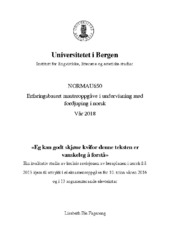| dc.contributor.author | Fagereng, Lisabeth Eie | |
| dc.date.accessioned | 2018-08-07T11:09:13Z | |
| dc.date.available | 2018-08-07T11:09:13Z | |
| dc.date.issued | 2018-06-16 | |
| dc.date.submitted | 2018-06-15T22:00:05Z | |
| dc.identifier.uri | https://hdl.handle.net/1956/18011 | |
| dc.description.abstract | I 2013 vart læreplanen i norsk Kunnskapsløftet frå 2006 revidert (Utdanningsdirektoratet). Revisjonen førte mellom anna med seg at sjangernemningar, som til dømes artikkel, diskusjonsinnlegg og formelt brev, vart fjerna frå kompetansemåla. I staden inneheld kompetansemåla i den reviderte læreplanen teksttypar; kreative, informative, reflekterande og argumenterande tekstar. Endringa baserer seg på ei funksjonell og kontekstuell skriveopplæring, kor føremål og mottakar er løfta fram som viktig grunnlag for tekstskaping. Føremålet med denne studien er å sjå på korleis intensjonen bak læreplanrevisjonen kjem til uttrykk i eksamensoppgåve A2 frå hovudmålsettet for 10. trinn våren 2016, samt studera korleis intensjonen bak endringane kjem til uttrykk i 13 elevtekstar som svarar på denne oppgåva. Argumenterande tekstar står sentralt i analysane. Dette kvalitative forskingsprosjektet analyserer først Oppgåve A2 med utgangspunkt i Otnes (2014) (2015) & Iversen (Otnes & Iversen, 2016) sine termar for kategorisering av skriveoppgåver. Som verktøy for å analysera elevtekstane har eg kombinert to modellar knytt til argumentasjon. Først har eg gjennomført ein analyse av tekstkomponentar i ein problem-løysing-struktur ut frå Tirkkonen-Condit (1985) sin teori. Vidare har eg gjennomført ein analyse av den grunnleggjande argumentasjonen i teksten med utgangspunkt i Toulmin (2003) sin argumentasjonsmodell. Kombinasjonen av analysemodellar gir to innfallsvinklar til same tekstmateriale, og dermed ulike perspektiv på korleis eleven oppfattar og responderer på oppgåveformuleringa. Studien har konstatert at læreplanrevisjonen kjem til uttrykk i eksamensoppgåva. Prosjektet gir innsyn i korleis ei skriveoppgåve som legg opp til overtydande skrivehandling materialiserer seg i tekstar med argumenterande superstruktur og fleire argumenterande trekk. Samstundes belyser studien at ei informasjonsrik oppgåve med detaljerte instruksar og kontekstinnrammingar er svært styrande for korleis elevar løyser oppgåva. Elevane ser ut til å ta funksjonelle val i høve til oppgåveinstruksen, men noko av utfordringa ligg i at oppgåva gir så spesifikke bestillingar at det ikkje er så mange reelle val att for eleven å ta. Elevane i utvalet får synt lesekompetanse og sjølvstendig kunnskap om lesing og lesestrategiar, men dei får ikkje eit stort rom til å syna at dei er funksjonelle skrivarar med kompetanse i tekstoppbygging og tekststruktur. | en_US |
| dc.description.abstract | In 2013 the curriculum in Norwegian, Kunnskapsløftet from 2006 (Utdanningsdirektoratet), was revised. The revision entailed that genres such as articles, opinion pieces and formal letters were removed from the competence aims. The competence aims in the revised curriculum instead uses creative, informative, reflecting and argumentative texts. The revision was based on a functional and contextual view on writing where purpose and recipient are seen as important elements in text writing. The purpose of this project is to analyse how the intention behind the curriculum revision was expressed in “Oppgåve A2” from the Year 10 final exam in the spring of 2016. In addition, 13 student answers to “Oppgåve A2” were used to study how the intention behind the curriculum revision was reflected in their answers. Argumentative texts are central to the analysis. In this qualitative research project, the first objective was to analyse “Oppgåve A2”. The terms used for categorizing the writing tasks are borrowed from Otnes (2014) (2015) & Iversen (Otnes & Iversen, 2016). In the second objective two different argumentative analysis tools have been used in order to analyse the student texts. The first part of this study consists of an analysis of the text components in a problem-solution structure from the theory of Tirkkonen-Condit (1985). The second part of this study used the argumentation model of Toulmin (2003) to analyse the fundamental argumentation in the texts. This combination of the two models provides two different angles to the same text material, and therefore different perspectives to how the students understand and respond to the writing task. The results presented in this thesis shows that the curriculum revision is reflected in “Oppgåve A2”. The project also shows how a writing task, which asks for persuasive writing, results in texts with an argumentative superstructure and several argumentative characteristics. At the same time, the study illustrates that a task that is rich in information, with detailed instructions and contextualisation, is very influential in how students solve the task. The students seem to make functional decisions according to the instructions, but some of the challenge lies in the task giving orders that are so specific that there are not any real choices left for the students to make. The students in the selection get to showcase their knowledge about reading and reading strategies, but they are not given much room to demonstrate their skills as competent writers. | en_US |
| dc.language.iso | nno | eng |
| dc.publisher | The University of Bergen | eng |
| dc.subject | Læreplanrevisjoner | |
| dc.subject | Skriveopplæring | |
| dc.subject | Norge | |
| dc.title | «Eg kan godt skjøne kvifor denne teksten er vanskeleg å forstå» Ein kvalitativ studie av korleis revisjonen av læreplanen i norsk frå 2013 kjem til uttrykk i ei eksamensoppgåve for 10. trinn våren 2016 og i 13 argumenterande elevtekstar | eng |
| dc.type | Master thesis | |
| dc.date.updated | 2018-06-15T22:00:05Z | |
| dc.rights.holder | Copyright the author. All rights reserved | eng |
| dc.description.degree | Erfaringsbasert masteroppgåve i undervisning med fordjupning i norsk | |
| dc.description.localcode | VID-MAUNOR | |
| dc.description.localcode | NORMAU650 | |
| dc.subject.nus | 711123 | eng |
| fs.subjectcode | NORMAU650 | |
| fs.unitcode | 11-21-0 | |
